Volume 1-8 (2009-16)
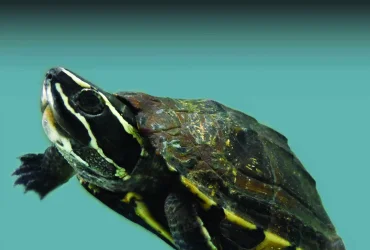 v8i1.209
v8i1.209ISSN: 1800-427X (print)
eISSN: 1800-427X (online)
DOI:10.47605/tapro.v8i1.209
Submitted date: 21 January 2016
Accepted date: 18 February 2016
Published date: 26 March 2016
Pp. 1–9.
A NEW SNAIL-EATING TURTLE OF THE GENUS Malayemys LINDHOLM, 1931 (GEOEMYDIDAE) FROM THAILAND AND LAOS
Montri Sumontha, Timothy R. Brophy, Kirati Kunya, Suthep Wiboonatthapol & Olivier S.G. Pauwels*
*Corresponding author. E-mail: osgpauwels@yahoo.fr
Abstract
We describe a snail-eating turtle, Malayemys isan sp. nov., from the Mekong River Basin in northeastern Thailand (Nong Bua Lamphu, Nong Khai and Udon Thani provinces) and the adjacent Vientiane area in Laos. The new species is readily distinguishable from M. subtrijuga by its two (vs. six to nine) nasal stripes, and from both M. subtrijuga and M. macrocephala by its thin, often discontinuous, infraorbital stripe that never reaches the loreal seam. This geographically-restricted new species is sold in several food markets throughout the species‟ distribution and is in urgent need of conservation measures.
Key words : Aquatic ecosystems, biodiversity, herpetofauna, Mekong, snail-eating turtle
Section Editor: Thasun Amarasinghe
eISSN: 1800-427X (online)
DOI:10.47605/tapro.v8i1.209
Submitted date: 21 January 2016
Accepted date: 18 February 2016
Published date: 26 March 2016
Pp. 1–9.
A NEW SNAIL-EATING TURTLE OF THE GENUS Malayemys LINDHOLM, 1931 (GEOEMYDIDAE) FROM THAILAND AND LAOS
Montri Sumontha, Timothy R. Brophy, Kirati Kunya, Suthep Wiboonatthapol & Olivier S.G. Pauwels*
*Corresponding author. E-mail: osgpauwels@yahoo.fr
Abstract
We describe a snail-eating turtle, Malayemys isan sp. nov., from the Mekong River Basin in northeastern Thailand (Nong Bua Lamphu, Nong Khai and Udon Thani provinces) and the adjacent Vientiane area in Laos. The new species is readily distinguishable from M. subtrijuga by its two (vs. six to nine) nasal stripes, and from both M. subtrijuga and M. macrocephala by its thin, often discontinuous, infraorbital stripe that never reaches the loreal seam. This geographically-restricted new species is sold in several food markets throughout the species‟ distribution and is in urgent need of conservation measures.
Key words : Aquatic ecosystems, biodiversity, herpetofauna, Mekong, snail-eating turtle
Section Editor: Thasun Amarasinghe
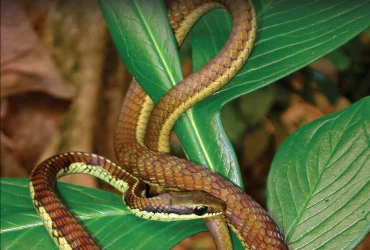 v3i2.57
v3i2.57ISSN: 1800-427X (print)
eISSN: 1800-427X (online)
DOI:10.47605/tapro.v3i2.57
Submitted date: 29 July 2011
Accepted date: 29 October 2011
Published date: 20 December 2011
Pp. 110–111.
Unusual affiliative behaviour in orang-utans (Pongo pygmaeus) - Sabah, Malaysia
Lee E. Harding*
*E-mail: harding@sciwrite.ca
Adult male and female orang-utans are usually described as solitary (Delgado Jr & Van Schaik, 2000; Galdikas, 1985; Poole, 1987; Rodman & Mitani, 1987; Weiss et al., 2006), the female providing the only infant care, as far as is known. Adult males, which are twice the size of adult females, do not associate with females except for sex; adult males may associate with subadult males, but not for companionship: it usually involves competition for a receptive female
Section Editor: Colin Groves
eISSN: 1800-427X (online)
DOI:10.47605/tapro.v3i2.57
Submitted date: 29 July 2011
Accepted date: 29 October 2011
Published date: 20 December 2011
Pp. 110–111.
Unusual affiliative behaviour in orang-utans (Pongo pygmaeus) - Sabah, Malaysia
Lee E. Harding*
*E-mail: harding@sciwrite.ca
Adult male and female orang-utans are usually described as solitary (Delgado Jr & Van Schaik, 2000; Galdikas, 1985; Poole, 1987; Rodman & Mitani, 1987; Weiss et al., 2006), the female providing the only infant care, as far as is known. Adult males, which are twice the size of adult females, do not associate with females except for sex; adult males may associate with subadult males, but not for companionship: it usually involves competition for a receptive female
Section Editor: Colin Groves
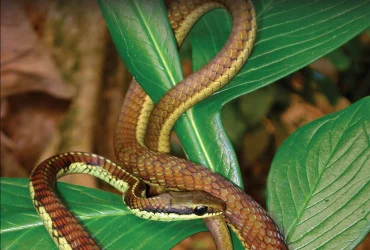 v3i2.56
v3i2.56ISSN: 1800-427X (print)
eISSN: 1800-427X (online)
DOI:10.47605/tapro.v3i2.56
Submitted date: 15 October 2011
Accepted date: 01 November 2011
Published date: 20 December 2011
Pp. 107–109.
Rare mammals recorded in Borneo – Malaysia
Lee E. Harding*
*E-mail: harding@sciwrite.ca
While on a wildlife-watching trip to Sabah, Borneo, May 21 to June 5, 2011, Jeffrey Harding and I saw several rare and endangered mammal species whose distributions are not well known. Following is a list of the rarest ones with notes on location, elevation, and conservation status. Elevations were taken with a Barigo altimeter. Conservation status notes are based on IUCN (2011). Taxonomy follows Wilson & Reeder (2005). Evidence included field notes and photographs for most species mentioned below. I offer these notes in case they may be of use in future conservation efforts or distribution studies.
Section Editor: Colin Groves
eISSN: 1800-427X (online)
DOI:10.47605/tapro.v3i2.56
Submitted date: 15 October 2011
Accepted date: 01 November 2011
Published date: 20 December 2011
Pp. 107–109.
Rare mammals recorded in Borneo – Malaysia
Lee E. Harding*
*E-mail: harding@sciwrite.ca
While on a wildlife-watching trip to Sabah, Borneo, May 21 to June 5, 2011, Jeffrey Harding and I saw several rare and endangered mammal species whose distributions are not well known. Following is a list of the rarest ones with notes on location, elevation, and conservation status. Elevations were taken with a Barigo altimeter. Conservation status notes are based on IUCN (2011). Taxonomy follows Wilson & Reeder (2005). Evidence included field notes and photographs for most species mentioned below. I offer these notes in case they may be of use in future conservation efforts or distribution studies.
Section Editor: Colin Groves
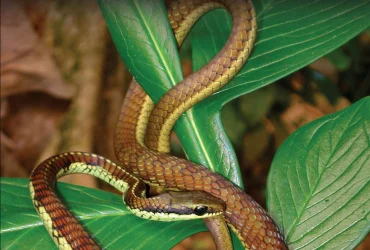 v3i2.55
v3i2.55ISSN: 1800-427X (print)
eISSN: 1800-427X (online)
DOI:10.47605/tapro.v3i2.55
Submitted date: 15 October 2011
Accepted date: 01 November 2011
Published date: 20 December 2011
Pp. 104–106.
First Report of a Cerambycid beetle (Capnolymma cingalensis) from India
H.V. Ghate*, C.A. Viraktamath & R. Sundararaj
*Corresponding author. E-mail: hemantghate@gmail.com
Lepturinae are a group of Cerambycidae that can be recognized by their peculiar form, especially the head being prolonged behind into a ‘neck’.
Section Editor: Eduard Vives
eISSN: 1800-427X (online)
DOI:10.47605/tapro.v3i2.55
Submitted date: 15 October 2011
Accepted date: 01 November 2011
Published date: 20 December 2011
Pp. 104–106.
First Report of a Cerambycid beetle (Capnolymma cingalensis) from India
H.V. Ghate*, C.A. Viraktamath & R. Sundararaj
*Corresponding author. E-mail: hemantghate@gmail.com
Lepturinae are a group of Cerambycidae that can be recognized by their peculiar form, especially the head being prolonged behind into a ‘neck’.
Section Editor: Eduard Vives
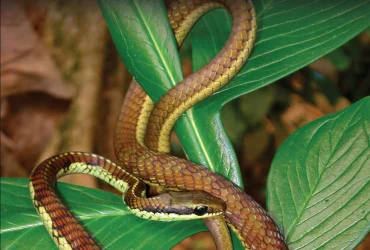 v3i2.54
v3i2.54ISSN: 1800-427X (print)
eISSN: 1800-427X (online)
DOI:10.47605/tapro.v3i2.54
Submitted date: 10 August 2011
Accepted date: 22 August 2011
Published date: 20 December 2011
Pp. 102–103.
First record of banded krait (Bungarus fasciatus) from Pilibhit District, Uttar Pradesh - India
Meraj Anwar*
*E-mail: anwar.meraj@gmail.com
The banded krait, Bungarus fasciatus (Schneider, 1801) is one of the venomous elapids of the genus Bungarus Daudin, 1803, widely distributed in South and South-East Asia.
Section Editor: Gernot Vogel
eISSN: 1800-427X (online)
DOI:10.47605/tapro.v3i2.54
Submitted date: 10 August 2011
Accepted date: 22 August 2011
Published date: 20 December 2011
Pp. 102–103.
First record of banded krait (Bungarus fasciatus) from Pilibhit District, Uttar Pradesh - India
Meraj Anwar*
*E-mail: anwar.meraj@gmail.com
The banded krait, Bungarus fasciatus (Schneider, 1801) is one of the venomous elapids of the genus Bungarus Daudin, 1803, widely distributed in South and South-East Asia.
Section Editor: Gernot Vogel
Hubungi Kami
The ultimate aim of the journal is to provide an effective medium for communication of the latest and best scientific information.
Copyright © 2020 Taprobanica. All Rights Reserved
Jasa Pembuatan Website by IKT




